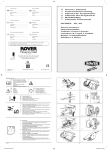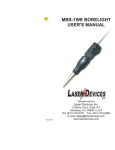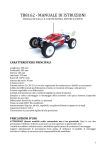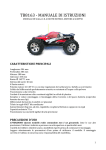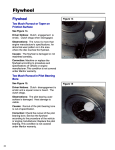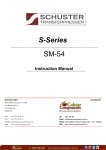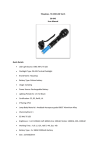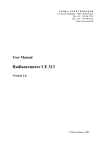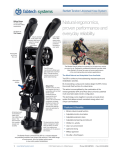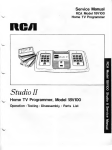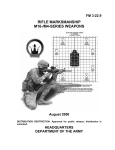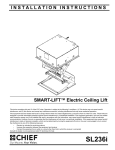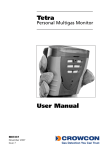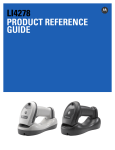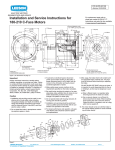Download Final OTAL ITAL May 2005
Transcript
Images copyright Laser Devices, Inc. 2000 Super Power Point Trademark of Laser Devices, Inc. 2 Harris Court, Suite A-4 Monterey, CA 93940 U.S.A. LASER LIGHT Tel: (831) 373-0701 Fax: (831) 373-0903 E-mail: [email protected] Internet: www.laserdevices.com AVOID DIRECT EYE EXPOSURE OUTPUT 5mW WAVELENGTH 632 - 650nM CLASS IIIa LASER PRODUCT Document P/N 1003 Rev. May 2005 USER’S MANUAL Laser Aiming Device ITAL AND OTAL Super Power Point (635nM) Infrared (835nM) NSN 1005-99-535-5506 ITAL P/N19001(SPP) ITAL P/N19002(IR) OTAL P/N19101(SPP) OTAL P/N19102(IR) Made in the U.S.A. U.S. Patent #5581898 Warranty Warning Infrared Laser Light Laser Devices, Inc. (LDI), offers a one-year limited warranty (excluding batteries and light bulbs) from the date of original purchase against failure due to defect in design, parts and workmanship. The warranty is void if the product serial number has been removed or if the product has been misused, modified or abused. LDI will replace defective products at its discretion. To the maximum extent permitted by law, LDI disclaims all other warranties, whether expressed or implied, including but not limited to implied warranties of merchantability and fitness for a particular purpose. In no event shall LDI or its suppliers, distributors, dealers or agents be liable for any damages whatsoever (including without limitation damages for personal injury, wrongful death or pecuniary loss) arising out of the use or the inability to use any LDI manufactured product. This limited warranty gives the purchaser specific legal rights, which may vary by state and jurisdiction. This aiming laser emits laser light that has been determined to pose a risk of eye injury. In order to avoid the possibility of eye injuries resulting from direct viewing, please adhere to the following warnings: * Never look directly into the laser beam. * Do not look directly at the laser light using scopes, binoculars or night vision equipment. * Avoid shining the laser onto mirrored surfaces. * Observe all safety precautions with the laser that you would observe with a loaded firearm. * Avoid extended activation, especially in rain, mist, fog, smoke or dusty conditions, as the laser beam can give away your position to the enemy. 32 Accessories and Parts (cont'd) - + 30 LASER LIGHT AVOID DIRECT EYE EXPOSURE OUTPUT 5mW WAVELENGTH 632 - 650nM CLASS IIIa LASER PRODUCT 1 General Information Part # 1.5 Volt AA Battery 30115 Daytime Shooting Glasses, High Efficiency Daytime Shooting Glasses, Standard Efficiency 30204 30203 Target "Accur-Aim LaserTM" with 3 Strips Target Strips (35 Pieces) 30102 30143 Please read these handling and safety instructions and the instructions for your weapon before attempting to install or use this laser aiming device. Failure to comply with the installation instructions may result in damage to your weapon. Safety First Unload your firearm (remove the magazine and any cartridge in the chamber) prior to mounting the laser on your weapon. Please familiarize yourself with the location of the activation switch and pressure pad switch for the laser. Make sure the laser and the firearm are pointed in a safe direction prior to attaching the laser to the weapon. ! Activate the IR laser in a momentary fashion to avoid detection by enemy forces equipped with night vision goggles. ! Using the IR laser in rain, fog and mist may increase the possibility that the3 enemy will detect your position. Warning Infrared Laser Light Laser and Firearm Safety General Information Safety First Product Description Laser Technical Data Location of Major Parts Installation of the Laser Zeroing the Laser Adjusting Windage/Elevation Notes Table of Contents 1 2 3 3 4 5 7 8-13 14-15 16-17 Operating Instructions Operation Under Extreme Conditions Replacement of Batteries Removing the Laser User Maintenance Troubleshooting the Laser Service & Repair Accessories and Parts Export Control Warranty 18 19-20 21 22 23-24 25-26 27 28-30 31 32 Laser and Firearms Safety Export Control ALWAYS keep the gun and aiming laser pointed in a safe direction. ALWAYS be sure the gun is safe to operate and the barrel is clear of any obstruction. ALWAYS know your target and what is beyond it. ALWAYS wear eye and ear protection when shooting. ALWAYS store your aiming laser, firearm and ammunition so they are secure and not accessible to unauthorized persons. ALWAYS treat every gun as if it were loaded. NEVER direct an aiming laser at a mirrored surface. NEVER look into an IR aiming laser to determine whether it is activated. NEVER look directly into the laser light using night vision goggles, optical scopes, telescopes or binoculars. Purchaser agrees to abide by all laws and regulations relating to the sale of the device, including any license required by the U.S. Department of State or U.S. Department of Commerce prior to export. Purchaser also agrees to abide by all laws, rules and regulations in effect in the jurisdiction where the product will be used. 31 2 Product Description Accessories and Parts (cont’d) Momentary Pressure Switch Right Angle Connector with 15 cm Connector Momentary Pressure Switch Right Angle Connector with 20 cm Connector Momentary Pressure Switch Right Angle Connector with 25 cm Connector Momentary Pressure Switch Straight Connector with 15 cm Connector Momentary Pressure Switch Straight Connector with 20 cm Connector Momentary Pressure Switch Straight Connector with 25 cm Connector The ITAL and OTAL are compact, waterproof aiming devices manufactured to meet the unique requirements of military special operations teams. The systems are waterproof to 30 meters. The ITAL and OTAL systems mount on any standard NATO 1913 rail. The low profile design is intended to mount in front of most optical scopes. The lasers are fully adjustable for windage and elevation for precise alignment at a variety of ranges. The ITAL laser is in line with the center line of the barrel, and is used on flat top rifles or when the laser is mounted in front of the front blade sight. OTAL features an offset laser for use behind the front sight of the weapon. 6 Volt Tac/Light Assembly with 1” Ring 9 Volt Tac/Light Assembly with 1” Ring 70710 70712 70713 70711 70714 70715 21113 14155 29 4 Laser Technical Data Accessories and Parts Mounting Rails: Picatinny/Weaver Mount for AK-47 Picatinny/Weaver Mount, Long (85.34mm) for 11.4mm to 19mm Picatinny/Weaver Mount, Long (85.3mm) for 19mm to 25.4mm Picatinny/Weaver Mount, Short (56.64mm) for 11.4mm to 19mm Picatinny/Weaver Mount, Short (56.64mm) for 19mm to 25.4mm LDI Part # 24568 24449 24453 24447 24448 28 Troubleshooting the Laser (cont’d) 4. If laser is impossible to Zero, please check the following: a. If the windage or elevation adjustment screw is at its maximum limit or is getting difficult to turn, check that the mounting bracket is properly aligned with the weapon barrel. b. If the impact point appears to move, confirm that the mounting bracket is firmly attached to the weapon. Also check to make sure that the laser is firmly attached to the weapon so that it does not move under recoil forces. If you suspect that the mount is moving, tighten the mounting screw. Also tighten the thumb nut securing the laser to the mounting bracket using a screwdriver or coin. 4. If the aiming laser still fails to operate, please contact LDI for assistance. 26 Laser Class Optical Output Beam Diameter Range Environment Material Color Length Width Weight Height Battery Battery Life Lens Diode Life Class IIIb for infrared 3.5mw or less 0.58 cm2 at 25m 450m (visibility may depend on the generation of NVG) Waterproof to 30 meters Anodized aircraft aluminum 6061T-6 Flat black 8.12 cm 4.16 cm 140 grams (including battery) 2.82 cm without mount (3.75 cm with mount) 1.5 AA 5 hours continuous use Coated glass lens 10,000 hours Location of Major Parts (See Figure 1) Item 1. 2. 3. 4. 5. 6. 7. 8. 9. 10. 11. 12. 13. 14. 15. 16. 17. 18. 19. Description Laser Housing End Cover Assembly Indicator Knob Battery Cap Assembly Optical Reducer Assembly Windage and Elevation Assembly (x2) Cable with Pressure Pad Assembly (see accessories for options) 1.5 Volt Alkaline Battery (optional Lithium battery, not shown) Case Assembly Screws (Phillips head) (x2) Crossbar Stud (Picatinny mount) Compression Spring for Mount Rail Crossbar Alignment Stud Short Clamp for Weaver Base Thumb Nut Knurled Grommet for Battery Compartment Battery Installation Label Danger Label (not shown) Front Cap Assembly Battery Cap O-Ring Installation of the Laser (cont'd) If it is ever necessary to clean the LAD, rinse with fresh water and dry with a clean cloth. If it is necessary to clean the front cap (Part #03159) blow dust or debris off of the lens. If necessary, rinse the lens with fresh water and then use lens paper, lens cleaner or a cotton swab to clean the lens. Do not use gun oil or harsh chemicals to clean the front cap, as they may dissolve the silicone seal and damage the laser. Step 3. Installation of optional barrel mount (Part No. 24447 or 24448). Locate the position on the barrel where you wish to locate the laser aiming device. Attach the bottom brackets using the supplied hex screws. Tighten the bottom brackets firmly (see Figure 3). Check the alignment of the NATO 1913 rail to confirm that it is located in the correct position. If necessary, loosen the mounting screws and rotate the mounting rail into the correct position. Remove the battery to prevent the possibility of corrosion if the LAD is going to be stored for an extended period of time (e.g., more than a week or two). 24 Part No. 3491 A03458 021-1125 A03672 A04143 A03455 A03466 B30115 C01097 3282 0-109 3102 3101 3114 263 NA NA A03991 C00094 7 User Maintenance (cont'd) If the battery needs to be replaced, see the section on battery replacement. 5 Figure 3 9 6 Service & Repair This aiming laser was manufactured to provide years of rugged and dependable use. In the event the laser ever needs internal repair, please contact LDI or its European Service Center for a return authorization number. Once you obtain the return authorization number, package the product securely and return it postage paid to your service center. In the event the product is not covered by the warranty, you will be notified as to the nature and the cost of the necessary repair. USA: Laser Devices, Inc Europe: Technik Partner GmbH 2 Harris Court, A-4 Herrenlandstrasse 72 Monterey, CA 93940 USA D-78315 Radolfzell, GERMANY Tel: (831) 373-0701 Tel: (0049) 0 77 32 / 98 80 75 Fax: (831) 373-0903 Fax: (0049) 077 32 / 56 53 8 Email: [email protected] Email: [email protected] 27 Figure 1 In the event the laser fails to operate or appears to operate at a low power, please check the following prior to contacting the manufacturer for repair. 1. Fails to work. Confirm that the laser is a visible wavelength laser or use night vision goggles to view the IR laser. If the appropriate night vision goggles are being used, please check the following: a. Replace the battery. See battery replacement instructions. b. Check the battery installation to make sure the battery was installed with the positive(+) terminal facing out of the laser assembly as shown in Figures 1 & 2. 2. Laser light is weak or dim. a. Check the front cap and lens of the laser to make sure that it is not covered with dirt or powder residue. If the front cap is dirty, clean gently with a cotton swab or soft clean cloth taking care not to scratch the lens. 3. Clean the battery contact point on the battery cap to remove any corrosion. Step 1. Confirm that your weapon is unloaded. Step 2. If the weapon does not have a built-in NATO 1913 rail, install an optional NATO 1913 rail (see Figure 2). Suitable mounting locations include: a. Above the barrel b. Below the barrel c. Behind the front sight (OTAL only) d. Flat top rifle or on a built-in rail adapter system Troubleshooting the Laser Installation of the Laser 8 25 Figure 2 The LAD does not require any particular maintenance when used under normal conditions other than changing the battery and occasionally cleaning the unit. Prior to use the user should check the following: a. Test activation. b. Make sure remote cable is attached. c. Make sure the adaptor rail is firmly attached to weapon. d. Confirm that the rail clamp is tight. e. Check the sight alignment by test firing the weapon or by using the manufacturer’s optional laser borelight (LDI Part #FA3160-635). Step 4. Loosen the rail grabber knob so that the base will fit over the rail and the crossbars fit the cutouts in the rail. Move the LAD forward or backward until both crossbars are seated in a rail cutout (see Figure 4). Step 5. Tighten the thumb screw until it is tight. Use a coin or a screwdriver to firmly tighten so the LAD is securely mounted on the weapon. Step 6. Plug the pressure pad switch remote cable into the connector port on the back of the unit (see Figure 5). Rotate the locking ring on the presser pad switch in a clockwise direction to lock the remote cable into place (see Figure 6). Step 7. Locate the position on the foregrip for mounting the pressure pad switch. Peel the backing off of the velcro and attach the pressure pad to your weapon (see Figures 7 & 8). User Maintenance Installation of the Laser (cont'd) 23 10 Removing the Laser Step 1. Confirm that your weapon is unloaded. Step 2. Loosen the rail clamp knob. Use a screwdriver if necessary. Remove the laser from the rail. If the laser is going to be stored for a period of time, remove the batteries. Step 3. Remove optional NATO 1913 rail if necessary. Figure 12 22 Figure 4 Figure 5 11 Operation Under Extreme Conditions (cont’d) Dust and Sand Storms: Minimize activation of the LAD, as the laser light may give away your position. Keep laser stored in pack unless needed. If necessary, clean laser front cap as described in maintenance section. High Altitude Operation. No special procedures required. To clear dry dust or sand from the front cap, blow the dirt off the lens. If the lens mists up or becomes wet, use a clean cloth, lens cleaner or lens paper to clean the front cap. Figure 7 Figure 8 20 Operating Instructions Once the laser has been properly mounted on the weapon and properly adjusted for windage and elevation, the LAD is ready to use. Prepare the LAD for operation by turning the rotary switch from the OFF position to the ON/ Momentary position. In combat or when on patrol, operate the laser using the Momentary remote switch. REMEMBER, NIGHT VISION EQUIPMENT IS REQUIRED TO VIEW THE IR LASER POINT ON THE TARGET. If you accidentally activate the IR laser, you may reveal your position to opposing forces using night vision equipment. Avoid prolonged activation of the aiming laser in mist, fog, smoke, dust, high humidity, snow or rain conditions, as the laser beam may reveal your position to the opposing forces. When the laser is not being used, remember to turn the rotary switch back to the OFF position to prevent accidental activation. If the laser is to be stored for a long period, remove the batteries. 18 13 Zeroing the Laser (cont’d) Step 3. Confirm that your weapon is unloaded. Step 4. Adjust the windage or elevation by turning the windage or elevation knob by no more than one-quarter (1/4) turn. Windage: Turning the windage knob clockwise will move the laser point to the right, and turning the knob counter-clockwise will move it to the left. Elevation: Turning the elevation knob clockwise will move the laser point down, and turning it counterclockwise will move it up. Always move the laser point towards the bullet holes on the target Step 5. Test fire the weapon again to check the new alignment. If necessary, repeat the alignment process from Step 1. above. 15 Installation of the Laser (cont'd) Step 8. Attach the remote cable retainer clip to the wire. Peel the backing off and attach to the foregrip. Step 9. Test the laser for proper operation by turning the rotary switch into the Momentary position and depress the pressure pad switch. Use night vision goggles to view the laser point on the target. Step 10. Zero the unit for windage and elevation (see section on Zeroing the Laser). 12 Figure 6 Replacement of Batteries ITAL and OTAL use a single AA battery that will provide about 5 hours of continuous operation depending on temperature. When the laser light dims the battery needs to be changed. Follow the steps below to replace the battery. Step 1. Confirm that your weapon is unloaded. Step 2. Remove the battery cap on the front of the unit (turn counter-clockwise). Step 3. Remove the depleted battery. If necessary, remove the laser from the weapon. Step 4. Reinstall the new battery with the negative (-) terminal facing out of the housing (see Figures 1 & 12). Step 5. Screw the battery cap back on to the laser housing. Test the laser to confirm proper battery installation. (Use night vision goggles to view the IR beam). If the laser was removed from the mount, confirm that the laser point is still properly aligned for windage and elevation. 21 Extreme Heat. No special procedures required. Extreme Cold. Extreme cold will reduce battery life. For use in temperatures below -20oC or -5oF store alkaline batteries in an inner pocket. For operation in extremely low temperatures use optional lithium AA batteries. Salt Air. No special procedures required. Water, Mud, Snow. Confirm that the battery cap is firmly tightened. If the front cap has been loosened or replaced, confirm that it is also tight. Use the switch connector plug to seal the switch opening. Clean the LAD after use with fresh water and wipe dry with a clean cloth. If LAD front cap requires cleaning, see the section on user maintenance. In order to precisely align the laser to your weapon or to change the alignment for use at other distances, follow the steps below: Operation Under Extreme Conditions Zeroing the Laser Step 1. Aim the weapon using the laser aiming device at the target using a sandbag or steady rest. Place the laser point on the center of the target and carefully fire three rounds from the weapon and check the target for the impact point. Use night vision goggles to view the IR laser point. Step 2. If the bullet holes are clustered to one side or the other, then you will need to adjust the windage (see Figure 9 & 10). If the bullet holes are grouped above or below the target, then you will need to adjust the elevation (see Figure 11). 14 19 Adjusting Windage/Elevation Always adjust the windage and elevation knobs in one-quarter (1/4) turn increments or less. Move the laser towards the bullet holes in the target. Do not overadjust the windage or elevation, as it may damage the laser. Laser Point of Aim Bullet Holes Point of Impact Move Laser Down Use Elevation Laser Point of Aim Bullet Holes Point of Impact Move Laser to Right Use Windage Figure 10 Figure 11 Figure 9 16 17






